 Image search results - "matsuri01" Image search results - "matsuri01" |

The torches burn within seconds.
|
|

The fire at its peak was very hot to the skin. Sumiyoshi Shrine Fire Festival, Moriyama, Shiga in late Jan.
|
|

Sumiyoshi Shrine Fire Festival, Moriyama, Shiga Pref. on the second Sat. of January.
|
|

Even gaijin shrine maidens decorate bamboo branches or rakes. Toka Ebisu, Imamiya Ebisu Shrine, Osaka
|
|

Atsuta Jingu is one of Japan's most important shrines as it enshrines one of the three Imperial Regalia of Japan, the sacred (and perhaps legendary) sword called Kusanagi-no-Tsurugi ("Grass Cutting Sword"). 草薙の剣
|
|

The East torii gate of Atsuta Jingu Shrine, made of wood. Atsuta Jingu worships Atsuta-no-Ookami or Amaterasu-Omikami, the Sun Goddess represented by Kusanagi-no-tsurugi, the sacred sword.
|
|

Banner read "Happy New Year."
|
|
|

New Year's prayers at Atsuta Jingu Shrine on Jan. 1.
|
|

The shrine maidens came around to serve the tea and sweet.
|
|

Budo Hajime at the Budokan in early Jan. is a real spectacle. Kendo, judo, karate, sumo, naginata, kyudo.
|
|
|
|
|
|

Martial artists line up for free shiruko.
|
|
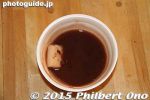
Shiruko, a confection of azuki bean soup with a piece of mochi. Served free of charge to everyone at the Budokan, including spectators.
|
|

I visited Fushimi Inari Taisha Shrine on Jan. 1, 2010. At the Kyoto City Tourist Info office, I asked which shrine was Kyoto's most popular on New Year's Day. They told me it was this shrine, so I came here.
|
|
|

How it looks from the top of the steps. Hordes of people coming to the shrine to pray for prosperity in the new year.
|
|

Fushimi Inari Taisha, Kyoto. Inch by inch, we crept toward the main shrine on New Year's Day.
|
|

2010 is the Year of the Tiger.
|
|

Entrance to the hiking trail of torii gates.
|
|

Second torii also has a fine view of Mt. Fuji.
|
|

Year of the Rooster, 2017
|
|

People pray for Good health, good job, prosperity, good school, good marriage partner (even though fewer people are getting married in Japan), etc.
|
|

Fujisan Hongu Sengen Shrine
|
|

Ema tablet with Mt. Fuji and a rooster. ¥1000
|
|

After the aikido, falconry demonstrations were held at Hama-Rikyu Gardens on Jan. 3 as a New Year's event. (放鷹術実演) Hama-Rikyu Garden used to be where the Tokugawa shoguns and the Imperial family practiced falconry.
|
|
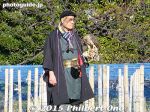
They don't use the same type of falconry birds that were used by Tokugawa shoguns. They now use Harris' hawks or red-tailed hawks imported to Japan. They are highly intelligent birds and can recognize human faces.
|
|

They allowed a few people from the audience to try falconry. This is an Italian who was lucky enough to be chosen to hold and release this hawk.
|
|
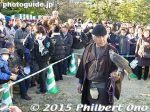
After the demo, they showed off the hawks for photos.
|
|
|
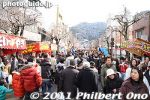
Inaba Shrine is Gifu city's main shrine. The path to the shrine is lined with food and souvenir stalls.
|
|
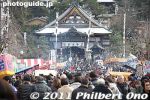
Inaba Shrine worships a god named Inishiki-Irihiko-no-mikoto who was a member of the Imperial family during the Kofun Period. The present shrine was built here in 1539.
|
|
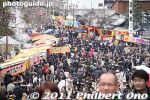
Pretty crowded, but it proceeded smoothly.
|
|
|
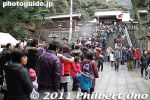
We had to wait a while...
|
|
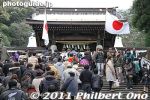
Approaching another gate called Shinmon. 神門
|
|

Inaba Shrine's Haiden Hall was where we could pray.
|
|
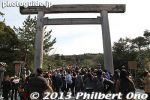
Ise Jingu Shrine's Naiku (Inner Shrine) is the main and most popular shrine at Ise. The shrine is rebuilt every 20 years and 2013 will mark the completion of the new shrine to replace the old one built in 1993.
|
|
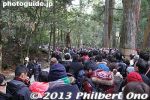
About 300-400 meters to the Naiku shrine, it got congested. It took about an hour to reach the foot of the steps going up to the shrine.
|
|
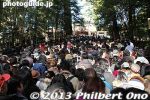
Naiku shrine and torii are in sight at the top of the steps ahead. We were told that it would take more than an hour just to get up these steps. However, we could walk up the steps quickly on the right edge of the steps.
|
|
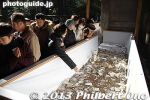
Look how small the offertory box is at Ise Jingu's Naiku. The one at Meiji Shrine in Tokyo is like half the size of a football field. Of course, Ise Jingu just doesn't have the space for it.
|
|
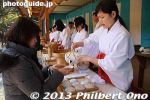
I wondered how much I should donate for this sake. I just dropped a 100 yen coin and probably got 20 yen worth of sake. At Atsuta Shrine (one of Japan's Big Three shrines) in Nagoya, they have a nice big hall where they serve hot tea and sweets for Nothing like that here.
|
|

Lots of people took selfies here in front of the torii and big stone pillar engraved with "IZUMO TAISHA." For Instagram of course.
|
|

Sando path to the shrine. 参道
|
|

Izumo Taisha's Haiden worship hall where you can hold prayers and other ceremonies like in a church. Rebuilt in 1959 after the previous one was lost in a fire in 1953. 拝殿
|
|

Izumo Taisha ema prayer tablet for the Year of the Dog.
|
|

Kemari Hajime at Shimogamo Shrine, Kyoto
|
|

Kemari Hajime at Shimogamo Shrine, Kyoto
|
|
|

Kehi Shrine's torii gate is one of Japan's three most famous wooden toriis. The other two being Miyajima's Itsukishima Shrine in Hiroshima Pref. and Kasuga Shrine in Nara.
|
|

Long line from the torii to the shrine on Jan. 1, 2016.
|
|

Kehi Jingu's main shrine. Kehi Jingu is dedicated to a number of gods including Emperor Chuai and Empress Jingu. So the Imperial Crest is all over the place.
|
|

Another ema tablet for 2016, the Year of the Monkey
|
|

Year of the Monkey ema from Kehi Jingu.
|
|

One of the six torches carried into the shrine.
|
|

Giant torches in Katsube Shrine, Moriyama, Shiga Pref.
|
|

Katsube Fire Festival: Men dance in rings in front of the fire. Also see the video at YouTube.
|
|
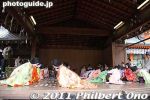
Karuta Hajime on the Noh stage at Yasaka Jinja Shrine, Kyoto on Jan. 3, 2011
|
|
|
|
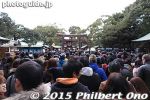
New Year's Day at Meiji Shrine. A total of 3 million people give New Year's prayers (Hatsumode) at Meiji Shrine. Japan's most popular shrine during New Year's.
|
|
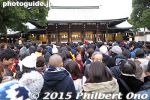
Meiji Shrine on New Year's Day
|
|
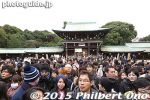
People behind me on New Year's Day at Meiji Shrine.
|
|
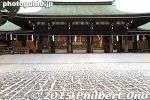
Money in the offertory pit on New Year's Day at Meiji Shrine.
|
|

In the past, police were hired to guard the money pit at Meiji Shrine. They also wore these face protectors to deflect the coins that fall short of the pit.
|
|

Lots of coins that fell short of Meiji Shrine's money pit. People no longer throw money from so far away. They wait until they get to the front.
|
|
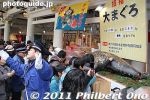
They also had a giant maguro tuna fish on display as an offering to the shrine from a fishing cooperative.
|
|
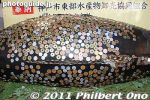
Coins stuck on giant tune at Nishinomiya Shrine Toka Ebisu.
|
|

It looks very crowded at Sumiyoshi Taisha, but it progressed quickly. Kept on walking most of the time.
|
|

Going up the shrine's taikobashi arch bridge called Sorihashi (反橋).
|
|

Sumiyoshi Taisha's Hongu No. 1 shrine, a National Treasure. Osaka city. Worships Sokotsutsu no Onomikoto (底筒男命).
|
|

People going to Hongu No. 1 shrine (left). In the distance is the back of Hongu No. 2 shrine.
|
|

Sumiyoshi Taisha's ema prayer tablet for 2019, Year of the Boar. ¥1000 絵馬
|
|

Giving New Year's prayers at Taga Taisha shrine.
|
|
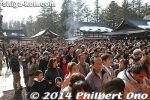
These people insist on praying front and center of the shrine. Even though they can easily go to the left or right side of the shrine to pray more quickly.
|
|

The shrine name means, "Many Felicitations," hence its popularity during New Year's.
|
|

Buying New Year's decorations and charms.
|
|

Dance by shrine maidens on New Year's Day 2005 at Taga Taisha Shrine.. Also see the 2005 video at YouTube.
|
|

Old New Year's decorations to be burned
|
|

Shrine maidens ready to toss the mochi at Hokoku Shrine. Another highlight of Toka Ebisu.
|
|
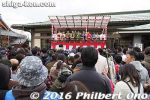
Throwing mochi rice cakes on Toka Ebisu, Hokoku Shrine, Nagahama, Shiga Pref.
|
|
|
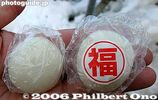
Good luck mochi rice cakes. I caught two of them. The kanji character is "fuku" meaning good luck.
|
|

Burning old New Year's decorations, Hokoku Jinja, Nagahama, Shiga Pref.
|
|
|
|
|
|
|